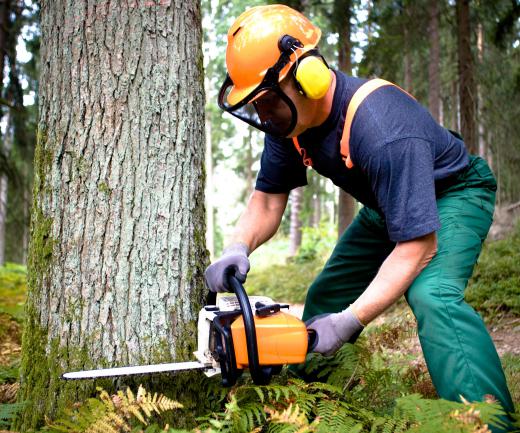Limbing is the logging practice of removing limbs prior to the shipping or processing of felled trees. There are a number of different forms of logging, and limbing can take place at different stages depending on which type is in use. When entire trees are felled whole, a logger will typically remove the limbs with a chainsaw after the tree is on the ground. Other types of logging use heavy machinery to remove the limbs at the same time the tree is cut down. The type of logging that is used and the variety of limbing that occurs depends largely on the size of the trees and the makeup of the landscape.
There are three different main types of logging that use varying types of machinery. Full-tree and tree-length logging both involve the felling of entire trees, which is the only way to deal with exceptionally large specimens. Cut-to-length logging is a variation that uses specialized equipment to cut trees to specific lengths right at the stump. Each of these methods can be associated with different types of limb removal, which can also be referred to as chasing or snedding.

In full-tree logging, the trees are felled before being hauled to a landing where they can be further processed. Loggers can then use chainsaws to manually top the trees and remove their limbs before bucking them up for transport. This type of limbing can be dangerous because the weight of a tree on its limbs can result in large amounts of potential energy. Loggers are usually very careful when performing this job, since a cut limb may snap back and cause a serious injury.
Tree-length logging involves the manual removal of limbs using chainsaws. This process is a little different, in that it usually involves limbing right at the stump site before the tree is moved to a landing to be bucked up and transported away. Many of the same dangers seen in full-tree logging can also be associated with this practice. The difference is that the loggers perform the limbing right at the stump, so they may be further away from help if something goes wrong.
The process of cut-to-length logging uses a highly mechanized process for limb removal. This type of logging usually requires two different heavy machines, the first of which is referred to as a harvester. Harvesters can grip an entire tree, cut it to length, and remove the limbs. This process can be less labor intensive because much of the work is performed by a machine, though the size of trees that can be handled by harvesters is usually limited.
